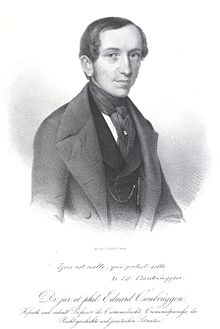Eduard Osenbrüggen
Eduard Osenbrüggen (born December 24, 1809 in Uetersen , Duchy of Holstein , † July 9, 1879 in Fluntern ) was a German-Swiss criminal law and legal scholar and travel writer .
Life
The son of the teacher Johann Osenbrüggen studied philology at the universities of Kiel and Leipzig after high school in Hildesheim . In 1835 he received his doctorate from the University of Kiel and was appointed private lecturer . By editing the stories for the Kriegelsche edition of the "corpus juris civilis" (Volume 3, Leipzig 1840), he started for the law to care. In 1841 he received his doctorate as Dr. iur. In 1843 he followed a call to the University of Dorpat as a full professor of criminal law and litigation, legal history and legal literature. In 1851 he had to give up his office due to disagreements with the Russian government and went to the University of Zurich as a full professor of criminal law and litigation , which he presided over three times as rector . In 1863 he became an honorary member of the Baltica Zurich Landsmannschaft, later the Corps Baltica Danzig . In 1869 he was naturalized in Fluntern. Because of his work, the city of Zurich granted him honorary citizenship in 1875 . He died on June 9, 1879 in Fluntern and was buried in the Fluntern cemetery.
Act
He had made a particular contribution to the theory of criminal law. His best-known legal texts include: The arson (1854), Casuistry of criminal law (1854) and The peace of the house (1857). He also wrote books on early Germanic history in Switzerland and books on cultural history about Switzerland, of which the works Kulturhistorische Bilder aus der Schweiz (1862 and 1864, 2nd edition 1867) and The High Mountains of Switzerland (1875) received special attention found.
Publications (selection)
- De jure belli et pacis Romanorum. Leipzig 1836. [1]
- On the interpretation of the corpus juris civilis. Kiel 1842. [2]
- Cicero's speech for Sextus Roscius from Ameria. Hamburg 1844. [3]
- Cicero's speech for T. Annius Milo. Hamburg 1844. [4]
- Nordic pictures. Leipzig 1853. [5]
- The arson in the criminal codes of Germany and German-speaking Switzerland. Leipzig 1854. [6]
- Casuistry of criminal law. Schaffhausen 1854. [7]
- The peace of the house. Erlangen 1857. [8]
- Treatises from German criminal law. Volume 1, Erlangen 1857. [9]
- German legal antiquities from Switzerland. Issue 1–3, Zurich 1858–59. [10]
- Alemannic criminal law. Schaffhausen 1860. [11]
- The criminal law of the Lombards. Schaffhausen 1863. [12]
- Cultural and historical images from Switzerland. Leipzig 1863. [13]
- Legal antiquities from Austrian Pantaidingen. Vienna 1863. [14]
- New cultural and historical images from Switzerland. Leipzig 1864. [15]
- The guest dishes of the German Middle Ages. Vienna 1865. [16]
- Cultural and historical images from Switzerland. Leipzig 1862/1864. 2nd Edition. 1867.
- Studies on German and Swiss legal history. Schaffhausen 1868. [17]
- Hiking studies from Switzerland. Volumes 1-5, Schaffhausen 1867-76. Volume 6, Basel 1881.
- Studies on German and Swiss legal history. Schaffhausen 1868. [18]
- The Swiss. Berlin 1874.
- The high mountains of Switzerland. 2nd Edition. Basel 1875.
- At home and abroad. Berlin 1875.
- Switzerland in the changes of modern times. Berlin 1876.
- The Gotthard and Ticino. Basel 1877.
- A metamorphosis in German criminal law. Berlin 1878.
- The Bernese Oberland. Darmstadt 1881.
literature
- Bruno Schmid: Osenbrüggen, Eduard. In: Historical Lexicon of Switzerland .
- Albert Teichmann : In memory of Eduard Osenbrüggen . In: The courtroom. Journal of Criminal Law, Criminal Trial, Forensic Medicine, Prison Studies, and Foreign Literature . Enke, Stuttgart. Vol. XXXI, pp. 321-326
- Max Planck Institute for European Legal History / Digital Library (legal journals of the 19th century)
- Meyers Konversations-Lexikon 6th edition (1905–1909)
- Eduard Osenbrüggen . In: Brockhaus Konversations-Lexikon 1894–1896, Volume 12, p. 669.
- Richard Loening: Osenbrüggen, Eduard . In: Allgemeine Deutsche Biographie (ADB). Volume 24, Duncker & Humblot, Leipzig 1887, pp. 463-468.
- Werner Weber: A stranger finds Switzerland. Eduard Osenbrüggen (1809-1879) . Kommissionsverlag Beer AG, Zurich 1986 (New Year's sheet for 1986, 149th issue)
- Jürgen Vortmann: Osenbrüggen, Eduard. In: New German Biography (NDB). Volume 19, Duncker & Humblot, Berlin 1999, ISBN 3-428-00200-8 , pp. 607 f. ( Digitized version ).
Web links
- Literature by and about Eduard Osenbrüggen in the catalog of the German National Library
- Overview of Eduard Osenbrüggen's courses at the University of Zurich (summer semester 1852 to summer semester 1879)
Individual evidence
- ^ Album Academicum des Corps Baltica-Borussia Danzig 1860-2000, Essen 2000, p. 83, No. 44
| personal data | |
|---|---|
| SURNAME | Osenbrüggen, Eduard |
| BRIEF DESCRIPTION | German-Swiss legal scholar, criminalist and travel writer |
| DATE OF BIRTH | December 24, 1809 |
| PLACE OF BIRTH | Uetersen |
| DATE OF DEATH | June 9, 1879 |
| Place of death | Whisper |
